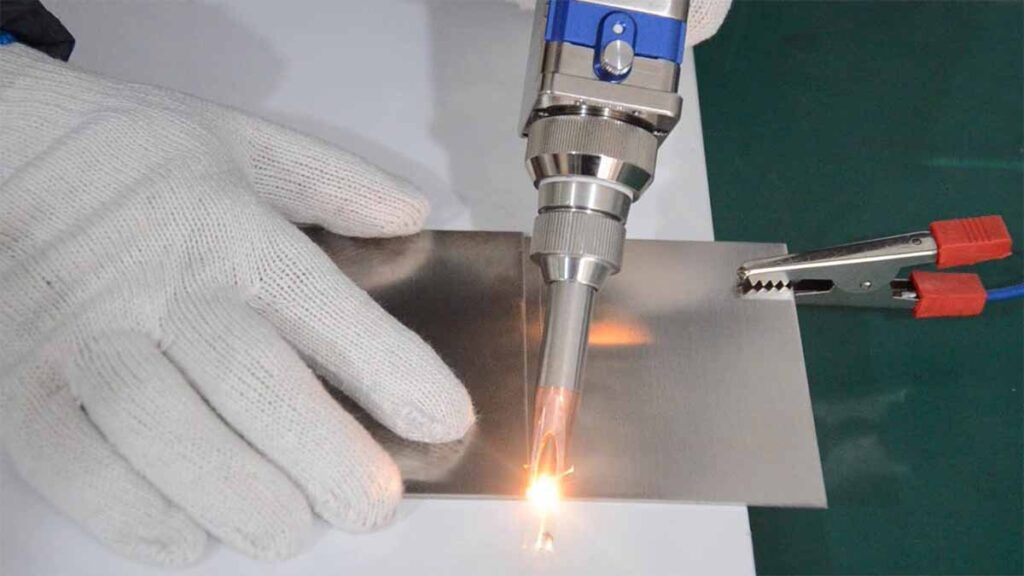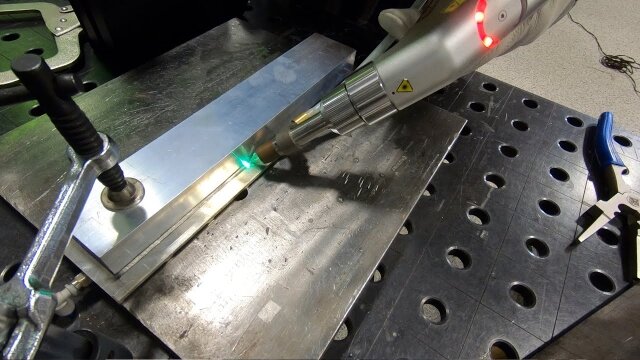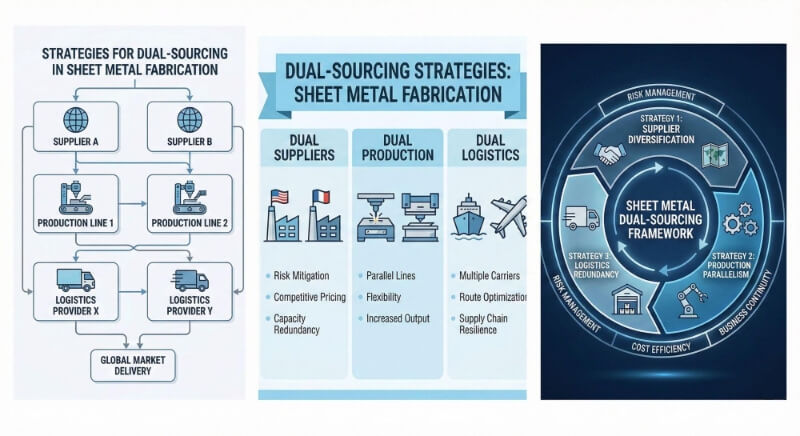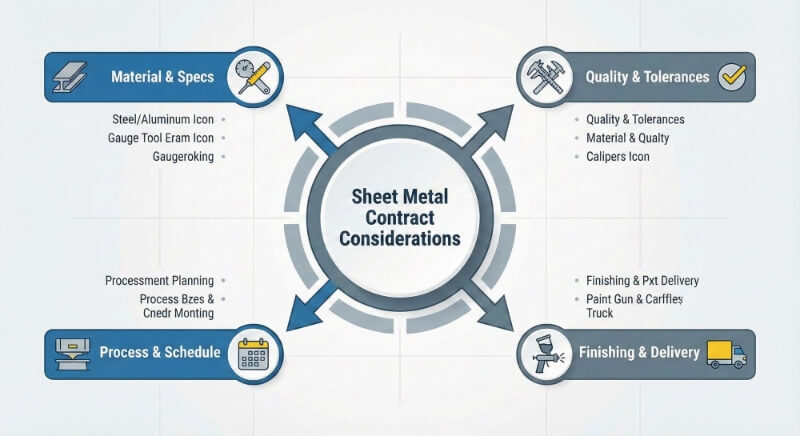Aluminum welding can be tricky. It has high thermal conductivity, a low melting point, and an oxide layer, making fusion harder. These factors cause distortion, porosity, and weak joints if done poorly. Laser welding offers a solution. It delivers precise, low-distortion welds and minimizes defects, even with aluminum’s challenging properties. Knowing how it works can help you get better, faster results.
Laser welding can improve part strength, reduce rework, and speed production. Let’s examine it step by step.

What Is Laser Welding Aluminum?
Laser welding aluminum melts and joins aluminum pieces with a focused laser beam. The heat is concentrated in a small area, creating a narrow, deep weld. Shielding gas, often argon or helium, protects the molten metal from air contamination. This process works well for both thin sheets and thicker sections, giving consistent and repeatable results.
Why Aluminum Needs Special Care in Welding?
Aluminum conducts heat quickly, which makes it harder to control during welding. Without proper control, the weld may not penetrate fully, or the heat-affected zone may become too wide. The oxide layer on aluminum has a higher melting point than the base metal, so cleaning the surface before welding is essential.
Aluminum also expands more than steel when heated, increasing the distortion risk. These properties mean the welding process needs accurate heat control and good preparation to ensure strong, defect-free joints.
Properties of Aluminum That Affect Laser Welding
Aluminum’s physical properties directly influence how it responds to laser welding. Knowing these factors helps set the correct parameters for clean and strong welds.
High Thermal Conductivity
Aluminum quickly carries heat through the base metal, pulling heat away from the weld pool. If the pool shrinks too soon, it loses penetration, often leading to a lack of fusion or a wide heat-affected zone.
To counter this, use a tight fit-up and keep travel speed steady. A higher power density helps maintain penetration. Shorter interaction times reduce heat spread. Backing bars and solid fixturing keep parts stable and flat during welding.
Oxide Layer Formation
Aluminum forms an oxide film within seconds of exposure to air. This film melts at a much higher temperature than the base metal. It can block fusion and trap gas if it remains, leading to porosity and weaker welds.
Remove oxides before welding by solvent wiping, stainless steel wire brushing, or light abrasion. Keep surfaces dry after cleaning. Start welding soon to reduce the chance of new oxide forming.
Reflectivity and Its Impact on Laser Absorption
Cold aluminum reflects much of the incoming laser energy. Heat coupling can be poor at the start, causing sputtering and uneven penetration. As the surface heats, absorption improves and the weld becomes more stable.
Keeping the surface clean and slightly matte can improve absorption. A tighter laser focus raises energy density. Green or blue laser sources work better with some grades and can provide a larger and more reliable process window.
Laser Welding Aluminum: The Process Breakdown
Laser welding aluminum follows a set sequence to produce clean, strong joints. Each step focuses on proper preparation, correct parameter settings, and complete protection of the molten pool.
First, prepare the work area and clean the aluminum surfaces. Remove oxide film, dirt, and oil. This step helps prevent porosity and poor fusion. Secure the parts with stable fixturing so they do not shift during welding.
Next, set the laser parameters. Adjust power, focus position, travel speed, and shielding gas flow to match the material thickness and grade. Use high-purity argon or helium for shielding. Keep gas coverage steady from start to finish.
Then, begin welding. The laser beam melts the joint edges and forms a molten pool. Shielding gas protects the pool from air until it solidifies. Maintain a steady travel speed and precise alignment for even penetration.
Finally, let the joint cool while shielding gas continues to flow. This prevents oxidation before the weld sets fully. Once cooled, inspect the weld visually. If needed, perform tests to check strength and detect defects.

Advantages of Laser Welding Aluminum
Laser welding has several benefits, making it a strong choice for many aluminum applications. These advantages improve quality, reduce rework, and shorten delivery times.
High Precision and Minimal Heat Distortion
The laser beam puts heat into a very small spot, keeping the heat-affected zone small and limiting distortion. Parts keep their shape, even with thin sections or close tolerances.
Strong and Consistent Welds
When settings are correct, the process gives deep penetration and full fusion. Weld quality stays steady from start to finish, even in long production runs. This reduces weak spots and makes performance more predictable.
Ability to Weld Thin and Complex Parts
Tight heat control allows welding of fragile aluminum without burn-through. The narrow beam can also reach complex joint shapes and tight corners that are difficult for other welding methods.
Faster Production Speeds for High-Volume Projects
Laser welding can work quickly, especially with automated systems. This makes it well suited for high-volume jobs where speed and repeatability matter. Less post-weld cleanup also helps cut total production time.
Choosing the Right Laser Source for Aluminum
The right laser source is essential for getting clean and strong aluminum welds. Each type has its own strengths and best uses.
Fiber Lasers
Fiber lasers have high beam quality and excellent energy efficiency. They work well for thin to medium-thickness aluminum. Their shorter wavelength improves absorption compared to CO₂ lasers. Fiber lasers are also easy to fit into automated systems, which makes them a common choice for high-volume production.
CO₂ Lasers
CO₂ lasers have a longer wavelength, and cold aluminum reflects more of this light. This makes starting the weld harder. They can still be effective for thicker sections when preheating or surface treatment is used. CO₂ lasers are often chosen for larger parts with good access to the weld area.
Disk Lasers
Disk lasers provide high beam quality with stable power output. They absorb well on aluminum and work for both thin and thick materials. Their steady performance over long production runs makes them reliable for jobs requiring consistent quality.
Process Parameters for Optimal Results
Strong, defect-free aluminum welds depend on getting the process settings right. Even small changes in these settings can noticeably affect weld quality and consistency.
Laser Power and Spot Size
The laser power needs to match the material thickness. For example, welding a 2 mm aluminum sheet often works well with around 3 kW of power. Thicker sections, such as 5 mm, may need closer to 5–6 kW. Too little power can leave parts unfused, while too much can cause spatter or distortion.
Spot sizes between 0.3 and 0.6 mm are standard. A smaller spot increases energy density and penetration, but can also raise the risk of burn-through on sheets under 1 mm thick.
Travel Speed and Focus Position
Travel speed affects how deep the weld penetrates and the shape of the bead. Thin sheets, around 1–2 mm, can often be welded cleanly at 3–5 m/min. Thicker plates may require slower speeds, around 1–2 m/min, for complete fusion.
For most aluminum welds, the focus is set at or slightly below the surface—about 0.1–0.2 mm. This helps keep the molten pool stable and supports strong joint formation.
Shielding Gas Type and Flow Rate
High-purity argon (99.999%) is the most common shielding gas because it is cost-effective and works well. Helium is sometimes used for thicker aluminum because it allows deeper penetration but costs several times more than argon.
Gas flow rates usually range from 15–25 L/min for argon and 20–30 L/min for helium. The key is to keep a steady flow that covers the weld pool until it cools, without creating turbulence that can pull air into the weld.
Applications of Laser-Welded Aluminum
Laser-welded aluminum is used in many industries that need strength, low weight, and neat welds. The fast and accurate process makes it a good choice for many parts.
Automotive Components and EV Battery Enclosures
In cars and electric vehicles, aluminum helps lower weight and improve energy use. Laser welding connects battery enclosures, body panels, suspension parts, and frame supports. The welds stay strong and cause little distortion.
Aerospace Structures and Panels
Aerospace parts must be light and strong. Laser welding is used for fuselage panels, interior frames, and fuel system parts. The process keeps dimensions accurate and reduces extra work after welding.
Electronics and Consumer Products
In electronics, aluminum housings and heat sinks need clean and precise welds. Laser welding limits heat so nearby parts stay safe. It is also used for home appliances, sports gear, and tools.
Marine and Offshore Structures
In marine use, aluminum resists rust from saltwater while keeping weight low. Laser welding is used for boat hulls, deck fittings, and underwater housings. The welds stay strong even in rough sea conditions.
Conclusion
Laser welding aluminum delivers precise, clean, and strong joints with minimal distortion. It works for thin sheets, thick sections, and complex shapes across many industries. By controlling heat, shielding, and beam focus, manufacturers can achieve consistent, high-quality results that reduce rework and speed up production.
We can provide precision laser welding services tailored to your project if you need reliable aluminum welding solutions. Contact us today to discuss your requirements and get expert support for your manufacturing needs.
Hey, I'm Kevin Lee

For the past 10 years, I’ve been immersed in various forms of sheet metal fabrication, sharing cool insights here from my experiences across diverse workshops.
Get in touch

Kevin Lee
I have over ten years of professional experience in sheet metal fabrication, specializing in laser cutting, bending, welding, and surface treatment techniques. As the Technical Director at Shengen, I am committed to solving complex manufacturing challenges and driving innovation and quality in each project.




